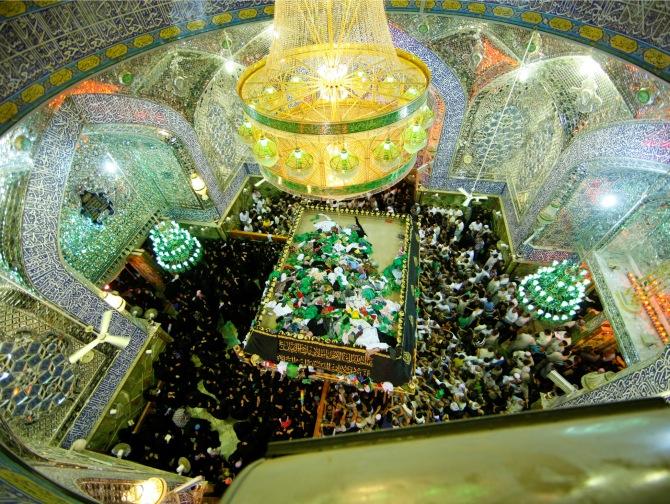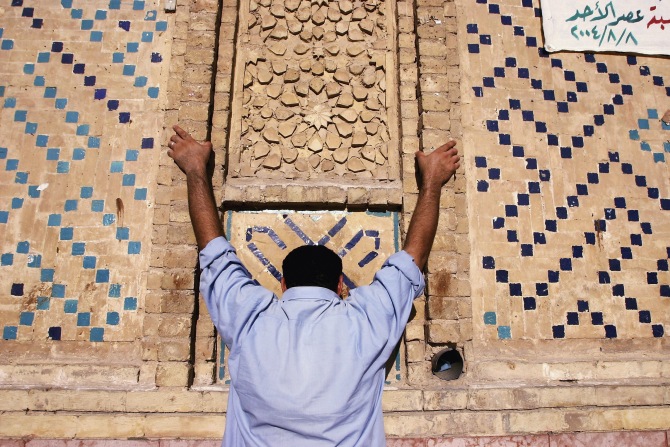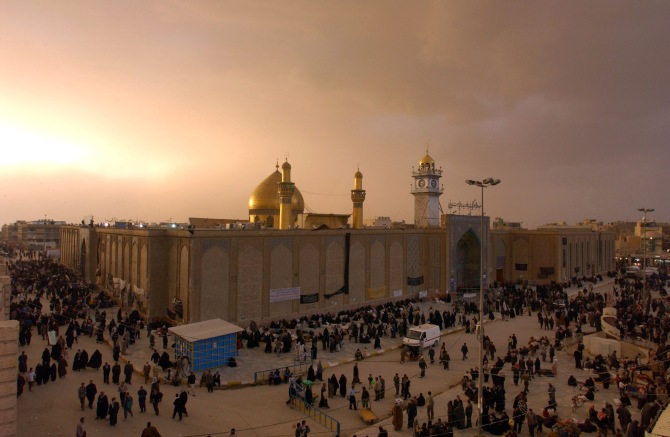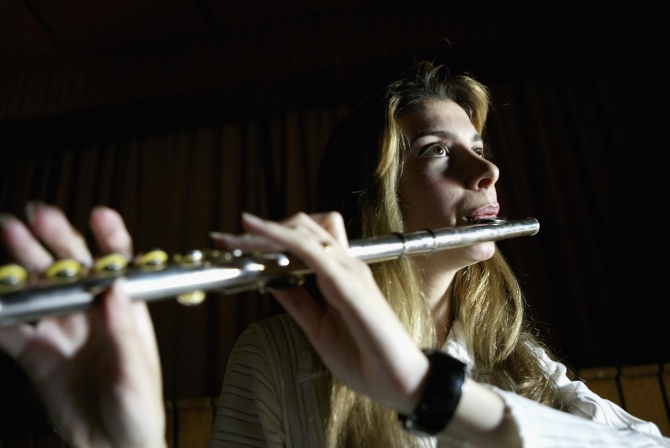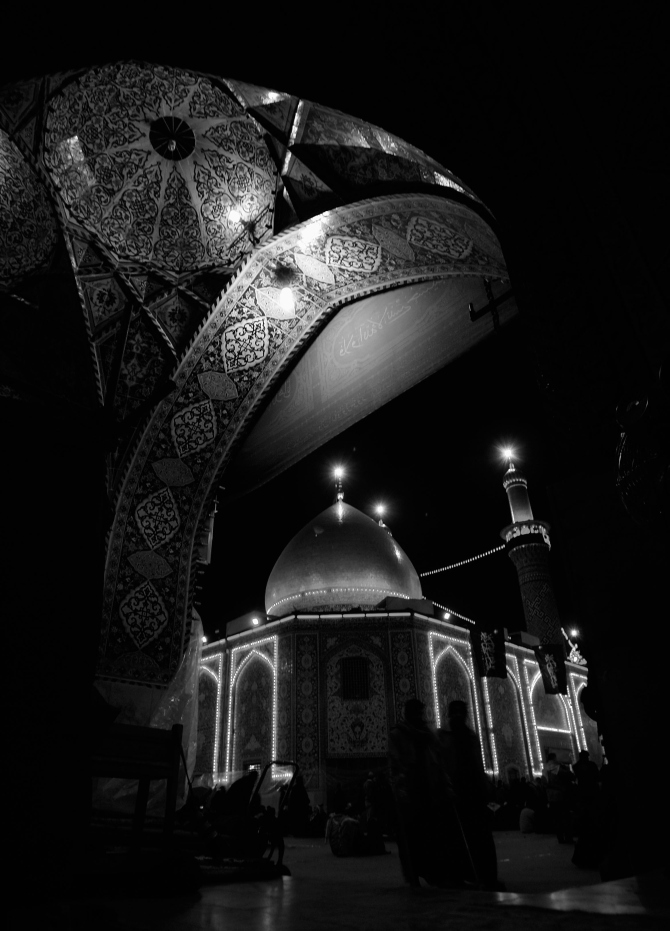 | « Back to article | Print this article |
At Iraq's holy shrines, signs of a country on the road to recovery
Arwa Sultanali, who visited Iraq’s holy cities of Najaf and Karbala, sends her impressions of the war-torn country.
After Mecca and Medina, Najaf and Karbala are the most revered by Shia Muslims. Even with all the news of war, terrorism, firing and bombing happening in Iraq, Shia Muslims are not deterred from visiting this least peaceful country in the world.
Belonging to a Shia family in Mumbai, I had a chance to visit Najaf and Karbala with them last month for 10 days. Iraq was not new to my parents. They had been there twice before, the last time in 2002, and they were happy to take out time again for a third trip.
Before leaving, I had no expectations of Iraq being an entertaining destination. Yet I was excited that I have a chance to travel to a war-torn country for the first time. I wanted an in-depth experience of the long-standing conjectures and descriptions of the world on Iraq and traveling there surely made all the difference.
We took off last month, but we were not alone. A small group of Shia Muslims from India were traveling with us too and we would all be given accommodation at common community hostel.
Our first stop was Najaf, a city in Iraq about 160 km south of Baghdad. We were flying there directly. Al Najaf International Airport was about four years old.
Click NEXT to read further...
At Iraq's holy shrines, signs of a country on the road to recovery
We normally always assume airports to be one of the busiest and noisiest spaces of the world. But here the story played out differently. It was so silent at the airport that I forgot how tired I was after the airplane journey.
After I stepped out of the airport, my eyes opened to a wide view of a barren, vast space with very few trees. We walked a few metres to coaster buses that were lined up for our arrival. They were in very good condition. Later, I came to know that these coasters were imported from neighbouring countries.
I thought to myself, “Surely a country that is struggling with a chronic short supply in food and basic amenities obviously doesn’t have the capacity or resources to host indigenous coaster buses. So the bus service is definitely a luxury in this country.”
After the men loaded all the bags, we took off to our community hostel. During my journey I noticed that there were many security check-points a little distance away from the airport. I saw armed security officials strictly checking a fleet of cars and buses at all these check-points.
I also saw many barbed wires twirled on the sides of the road where the armed officials walked. I couldn’t see their eyes. They always wore glares. Many of them were equipped with remote bomb detection sensors and were found using it typically on heavy vehicles such as our coaster buses.
Click NEXT to read further...
At Iraq's holy shrines, signs of a country on the road to recovery
When we were traveling through the broad freeways of Najaf, I noticed that the landscape of the city didn’t change much. I saw acres and acres of unproductive, fallow land everywhere.
I also noticed that the roads were very clean. The landscape around me made me realise the deep sense of isolation that this country has been living in for many, many years.
Shortly before our arrival, a prior group of travelers who stayed at the community hostel before us had already vacated the premises to go to Karbala. I saw an Iraqi worker bring dozens of bags down through the elevator.
Next, he stacked up all of the bags at the corner of the reception. I assume the rooms were already cleaned up before we arrived because I saw him taking an air-freshener upstairs to scent all the rooms.
After waiting for some time at the reception we were assigned rooms. At this time of the year, Iraq is terribly hot. It was a relief to get into an air-conditioned room after eight hours of traveling in the heat.
Few people in our group had a great sense of humour that really made us laugh especially when we were all not used to surviving in very hot temperatures. Lighter moments truly distracted our minds. I miss them and their jokes as well.
Click NEXT to read further...
At Iraq's holy shrines, signs of a country on the road to recovery
Najaf is renowned as the site of the tomb of Ali ibn Abi Talib, also known as “Imam Ali”, the First Imam of the Shiites, the cousin and son-in-law of the Prophet Muhammad whom the Shia Muslims consider to be the righteous caliph.
Najaf is also known for the Great Mosque of Kufa, or Masjid Al-Kufa. The mosque is located in Kufa, Iraq. It is one of the earliest mosques in the world. This mosque is most revered because it is the place where “Imam Ali” was fatally struck on the head while in Sujjood (prostrating) On the first day we went to the Haram with our group members.
(Haram in Arabic means sacred site). Pilgrims are checked for security reasons before entering the Haram. The checking process was such a trivial formality that anyone with a weapon could take it inside with ease. I think what they needed is an intelligent security system that could catch someone with a weapon off guard in seconds.
No mobiles or cameras are allowed inside the Haram. Shoes are also not allowed. Women and men went in separately.
The Haram today has grown magnificently since 2002. My parents were amazed by its sheer size. They said, “It was never that big and so widespread.” The Haram is also fully air-conditioned and open 24 hours of the day. Today Iraqis in the Haram have a chance to bask in its spaces. Many of them happily even sleep.
On our first day, our group sat together and listened to the mournful recitement of Imam Ali’s assassination delivered by our group leader. Many people in our group were quietly grieving while listening to him.
An Iraqi emotionally touched by the mentions of Imam Ali’s assassination lauded our group leader by picking up his ‘topi’ (hat) and putting it back on his head and then stroking it a few times. The group leader didn’t get distracted with this intriguing, non-verbal communication and I think he made a good decision by not reacting to it.
The Haram is housed in a grand structure with a gold gilded tomb and many precious objects in the walls. Many walls are also engraved with Kufic script. Kufic is the oldest calligraphic form of the various Arabic scripts and it is often used as decorative element at various holy sites situated in Muslim countries.
Nobody is allowed to touch the tomb of Imam Ali so that it remains forever protected from any sort of damage. The tomb is enclosed in a chamber. Even the high ceilings around the chamber and the top of the chamber are made of precious metals such as gold and silver and precious stones such as diamonds and rubies.
Most of these precious objects are imported from different parts of the world. All the objects used come together beautifully as a design that is stencilised on the high ceilings of the chamber. It looks stunningly spectacular.
The chamber sides are divided in such a way that men get more than half of the share to touch and prostrate against “Imam Ali’s” chamber.
Click NEXT to read further...
At Iraq's holy shrines, signs of a country on the road to recovery
While the men can pay respect with much ease, women had no option but to pay their respect the hard way. Their mettle was put to test by the sheer intensity of the pushing and prodding from various other robust women. At least to me, it just felt short of a stampede. I had sustained a terrible pain in my arms on the first day of visit to the Haram and my bag broke too while getting out.
Many of the women from our group were so smart that they would scuttle their way through slight openings from one particular corner of the chamber, prostrate against it and then keep moving in the side way direction and simultaneously continue prostrating till they reached the end of the other corner. Then, they would turn back and elbow out.
I too adopted this smart approach, but if I felt that the weight of other women was too much for me to handle, I would slide out from the mob half-way. I think I quit a few times in-between. Other times I went to the Haram at early morning hours. During that time, prostrating the chamber was a smooth sail.
There were women supervisors controlling the crowd 24 hours a day, but having them around doesn’t help the situation. I think what contributes to the pressure is that women are high on religion and they take too much time to move even an inch away near the chambers. Especially those women who don’t stay in Najaf are very persevering.
As in any other Gulf land, Iraq too has a Muslim law, wherein a woman is not allowed to show her hair and even her feet. I did not find it tough to follow this particular tenet and at the same time many Indian people from our group were not too conscious of their hair showing.
Yet there were times our group women were caught showing their hair and I was caught three times for showing mine. One occasion I remember particularly well. An Iraqi lady from the back patted me when I was almost close enough to grab a part of the chamber by my hands.
I looked back to see who it was. I saw her and she pointed to my hair and said, “Haraam (which means unholy)”.
I put my hair inside and continued closing in on the chamber. After I came out of the throng, I saw the same woman again. I was a bit afraid of her this time.
Before I could do anything or say anything, she tried to help me with my hair. When she was done, we smiled at each other and she left. It was nice spending a moment with her.
Iraqi women reminded me of beautiful nuns garbed in black cloth.
Click NEXT to read further...
At Iraq's holy shrines, signs of a country on the road to recovery
The dresses women they wore inside carried a charm of its earliest surviving Arab ethnicities. I found them intriguing. They were lacy and frilly, something I have never seen before.
For a moment I wondered which one is a true image of Muslim women. Was it the black fabric women cloaked themselves in or the modest, ethnic yet liberating dresses they wore within?
Every day we would visit the Haram where Imam Ali is buried and come back to our community hostel for some delicious food. Eating a tasty meal after a tiring day was a treat.
Our last stop was Karbala. We went there by bus. While traveling, I saw more broad freeways, quite, clean but appallingly empty roads. Commercial areas or even residential houses are very few and far between. House windows are always shut.
There are few billboards with women in ads and pointed flags in colours of silky green, black and red are spotted everywhere. Most of these flags are torn. I also passed through areas that had many incomplete, pending constructional works, abandoned overhead pathless wires and a collection of toppled furnishings.
Even with these circumstances, I would say all is not lost in Iraq. Commercialisation is making inroads. The city of Najaf and Karbala has grown around the shrine of the Haram. The city benefits from an end number of pilgrims and devotees that come to visit the site. Due to traffic generated from the visit of pilgrims, Najaf’s has its very own international airport.
The government has also started looking for professionals to invest in airport advertising.
There are subtle signs of improvement even in the infrastructure facilities provided, in the transportation used, in the overall cleanliness of the Harams and in the evolution of commerce in the country.
Earlier there were no commercial shops close to the Haram. Today a long row of shops exist around the Haram. Many women come there often to feast their eyes on what’s trending in apparel designs, shoes, etc. Various other items such as chocolates, scarfs, laces, textile material are also sold.
Click NEXT to read further...
At Iraq's holy shrines, signs of a country on the road to recovery
In 2002, when my parents visited Iraq, the Haram and its surrounding areas were unhygienic. Today the Haram has been sanitised, enclosed and air-conditioned. They are covered with a sea of carpets. They use fresheners, vacuum cleaners and a variety of advanced machines to keep the Haram clean and up to date.
Drinking water provisions are also available inside the Harams. Women are hired to clean and control crowds. So there is small working population of women too.
However, something more crucial than all of these improvements is the ability to defend oneself from giving up on life in an anemic environment of Iraq.
I believe that many Iraqis currently think tha it does no good to them to work because somebody else is going to reap the benefit of what they work for. This sort of mindset would mean the beginning of the end of Iraq’s survival and enrichment.
That is why, at least according to me, there is urgent need for government intervention in pushing for people’s upliftment and empowerment.
It would be discomforting for any country to be known in the world for being the place where the highest executions of the world take place, where the funeral business seems to be flourishing at a rapid rate and where the highest numbers of journalists in the world are attacked for doing their job. But this is Iraq’s current stark reality.
Coming back to my pilgrimage, Karbala contains the tomb of Hussein ibn Ali, grandson of Prophet Muhammadand the third Shia Imam. The mosque stands on the site of the grave of Hussein ibn Ali, where he was martyred during the Battle of Karbala in 680.
Another focal point of the Shia Muslims pilgrimage to Karbala is al-Makhayam, traditionally believed to be the location of Hussein's camp, where the death of Hussein and his followers is publicly commemorated. Many pious Shia Muslims ask to be buried in and around Karbala.
Click NEXT to read further...
At Iraq's holy shrines, signs of a country on the road to recovery
Karbala is also contains the tomb of Al-Abbas, half-brother of Hussein ibn Ali. He is revered for his loyalty to Imam Hussein, his respect for the Ahl al-Bayt, and his role in the Battle of Karbala. He was known as the greatest warrior in Arabia and mirrored the strength of his father, ‘Ali ibn Abi Talib.
Al-Abbas was buried at that ground where he fell from his horse in Karbala, Iraq. It is a short distance away from Imam Hussein’s shrine. A Haram is built around his grave to which millions of pilgrims visit and pay homage.
Shia Muslims have a firm conviction in Prophet Muhammad, his family members (Ahl al-Bayt) and descendants (including the Shia Imams) and their companions.
I have seen an Iraqi women putting water on the chamber in one of the Haram and then drinking that water. Another example is my mom asking me to put the dust that settles around the chamber on my forehead.
The architecture and design of the shrine of Imam Hussein is similar to that Imam Ali. There is also a similar security checking system in place for entering Imam Hussein’s shrine and women face congestion issues here too.
The city is one of Iraq's wealthiest, profiting both from religious visitors and agricultural produce, especially dates. Many people in Karbala also make their livelihood from services of an ancient transport system -- wooden carts that require pushing by hand.
In Karbala I also befriended a woman who hailed from Basra. She knew a bit of Hindi and she asked me personal questions. I told her I am not married and she appeared puzzlingly disturbed. I wanted her to relay her thoughts on young, unmarried, Muslim women.
I wanted to get in touch with her independent mind. I wanted to also ask her questions too, but my mom whisked me away like she always does and I had to go. I still remember bidding her farewell twice. I hope she is doing well.
When leaving Iraq I noticed that every sign post is written in Arabic and if there is anything written in English, there is always some spelling error. I also noticed that black seems to be the favourite colour of Iraqis.
I saw so many Arabic banners on black backgrounds.
Ten days after we came back from Iraq, yet another car bomb rocked the holy city of Karbala. The casualties of the car bomb that exploded in the industrial area of Karbala injured killed 26 people and injured 22.
Arwa Sultanali is a freelance journalist based out of Mumbai. She can be emailed at sultanali.arwa@gmail.com.
TOP photo features you missed last week
Click on MORE to see another PHOTO features...
